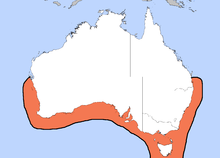| Giant cuttlefish | |
|---|---|

| |
| Giant cuttlefish from Whyalla, South Australia | |
| Scientific classification | |
| Domain: | Eukaryota |
| Kingdom: | Animalia |
| Phylum: | Mollusca |
| Class: | Cephalopoda |
| Order: | Sepiida |
| Family: | Sepiidae |
| Genus: | Sepia |
| Subgenus: | Sepia |
| Species: | S. apama
|
| Binomial name | |
| Sepia apama | |

| |
| Distribution of Sepia apama | |
| Synonyms | |
The giant cuttlefish (Sepia apama), also known as the Australian giant cuttlefish,[3] is the world's largest cuttlefish species, growing to 50 cm (20 in) in mantle length and up to 100 cm (39 in) in total length (total length meaning the whole length of the body including outstretched tentacles). They can be over 10.5 kg (23 lb) in weight.[4][5] Like all cuttlefish species, the giant cuttlefish has 8 arms and 2 feeding tentacles, as well as blue blood and 3 hearts.[6] Using cells known as chromatophores, the cuttlefish can put on spectacular displays, changing colour in an instant. The giant cuttlefish is native to temperate and subtropical waters of Australia, from Brisbane in Queensland to Shark Bay in Western Australia and Tasmania to the south. It occurs on rocky reefs, seagrass beds, and sand and mud seafloor to a depth of 100 m (330 ft).[7] In 2009 the species was listed at Near Threatened on the IUCN Red List of Threatened Species due to an observed declining trend at that time.[8]
- ^ Barratt, I.; Allcock, L. (2012). "Sepia apama". IUCN Red List of Threatened Species. 2012: e.T162627A931625. doi:10.2305/IUCN.UK.2012-1.RLTS.T162627A931625.en. Retrieved 19 November 2021.
- ^ Finn, Julian (2016). "Sepia apama Gray, 1849". World Register of Marine Species. Flanders Marine Institute. Retrieved 18 February 2018.
- ^ "Giant Cuttlefish - Sepia apama". Australian Museum. Retrieved 27 August 2014.
- ^ Reid, A., P. Jereb, & C.F.E. Roper 2005. Family Sepiidae. In: P. Jereb & C.F.E. Roper, eds. Cephalopods of the world. An annotated and illustrated catalogue of species known to date. Volume 1. Chambered nautiluses and sepioids (Nautilidae, Sepiidae, Sepiolidae, Sepiadariidae, Idiosepiidae and Spirulidae). FAO Species Catalogue for Fishery Purposes. No. 4, Vol. 1. Rome, FAO. pp. 57–152.
- ^ Poulsen, Adam (10 May 2017). "WA fisherman bags whopper cuttlefish". WAtoday. Retrieved 10 May 2017.
- ^ "Giant Cuttlefish".
- ^ Norman, M.D. 2000. Cephalopods: A World Guide. ConchBooks.
- ^ Barratt (SRLI), Iain; Allcock (SRLI), Louise (11 March 2009). "IUCN Red List of Threatened Species: Sepia apama". IUCN Red List of Threatened Species. Retrieved 29 May 2021.
